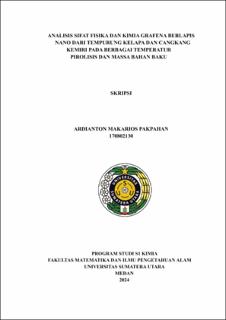Analisis Sifat Fisika dan Kimia Grafena Berlapis Nano dari Tempurung Kelapa dan Cangkang Kemiri Pada Berbagai Temperatur Pirolisis dan Massa Bahan Baku
Analysis of Physical and Chemical Properties of Coated Graphene Nano from Coconut Shells and Shells Cannamics at Various Temperatures Pyrolysis and Mass of Raw Materials

Date
2024Author
Pakpahan, Ardianton Makarios
Advisor(s)
Siburian, Rikson
Metadata
Show full item recordAbstract
Research on the analysis of the physical and chemical properties of
Nano-Coated Graphene (GBN) from coconut shells and candlenut shells using the
pyrolysis method has been carried out. The use of coconut shell in this research is
because it contains 33.61% cellulose and 19.27% hemicellulose and has a very high
carbon content. And candlenut shells contain 49.22% hemicellulose and 54.46% lignin
and have a very large carbon content. The aim of this research is to determine the
morphological (physical and chemical) properties of nano-coated graphene (GBN)
from coconut shells and candlenut shells due to variations in pyrolysis temperature and
raw material mass. This research is a laboratory experimental research. GBN was
synthesized using the pyrolysis method, and GBN products from each variation of
pyrolysis temperature and raw material mass were characterized using X-Ray
Diffraction (XRD) and Scanning Electron Microscopy Energy Dispersive X-Ray (SEMEDX).
XRD data from GBN shows that there is a weak and wide peak at C (002) (2Ɵ
= 24.7°), meaning that graphene was successfully produced. This XRD data is
supported by SEM-EDX data, GBN has a regular hexagonal morphology and GBN is
dominated by carbon atoms (C) 80 – 84% and oxygen (O) 12-19% (EDX data). The
optimum conditions for pyrolysis in coconut shells (temperature (TPirolysis), pyrolysis
time (tPyrolysis) and raw material mass) in the GBN production process are TPirolysis
= 600 °C; tPyrolysis = 4 and raw material mass = 500 gr, with an abundance of carbon
(85.26%) while the optimum conditions for candlenut shells are Tpyrolysis = 600 °C;
tPyrolysis = 4 and raw material mass = 500 gr, with carbon abundance (84.24%). All
data shows that GBN can be produced from coconut shells and candlenut shells. Shows
that research data on coconut shells and candlenut shells have potential as raw
materials for large-scale GBN production
Collections
- Undergraduate Theses [1411]
